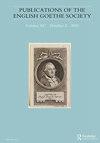范妮·门德尔松的Divan
IF 0.1
3区 文学
0 LITERATURE, GERMAN, DUTCH, SCANDINAVIAN
引用次数: 0
摘要
摘要本文将门德尔松1825年创作的歌德的《西游记》中的诗歌置于手稿语境中。我认为门德尔松从歌德的《布赫苏莱卡》中提取了叙事。她创作了一个由六首歌曲组成的循环,每首歌曲都有两次革命,每首歌都描绘了爱从分离到结合再到分离的道路。对门德尔松周期的研究使她的老师卡尔·弗里德里希·泽尔特进入视野。文章以费利克斯·门德尔松于1844年赠送给他的妻子塞西尔的《Stambuch》作为结尾,其中展示了威廉·亨塞尔和范妮(现)·亨塞尔的《Divan》音乐背景插图。本文章由计算机程序翻译,如有差异,请以英文原文为准。
Fanny Mendelssohn’s Divan
ABSTRACT This article considers Fanny Mendelssohn’s 1825 settings of poems from Goethe’s West-östlicher Divan in their manuscript context. I argue that Mendelssohn draws out narratives from Goethe’s ‘Buch Suleika’. She composes a cycle of six songs with two revolutions, each charting the path of love from separation through union to separation again. Investigation of Mendelssohn’s cycle brings her teacher, Carl Friedrich Zelter, into view. The article concludes with a Stammbuch presented by Felix Mendelssohn to his wife, Cécile, in 1844, which featured illustrated musical settings of the Divan by Wilhelm Hensel and Fanny (now) Hensel.
求助全文
通过发布文献求助,成功后即可免费获取论文全文。
去求助
来源期刊

Publications of the English Goethe Society
LITERATURE, GERMAN, DUTCH, SCANDINAVIAN-
CiteScore
0.10
自引率
0.00%
发文量
15
 求助内容:
求助内容: 应助结果提醒方式:
应助结果提醒方式:


